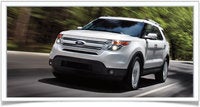Changed Brakes and Rotors on a 2004 Ford Explorer
Asked by Don Feb 18, 2018 at 06:33 PM about the 2004 Ford Explorer Limited V8 4WD
Question type: Maintenance & Repair
I changed the rear brakes and rotors on my mothers ford explorer, now the
driver side squeals at a certain point in the tire rotation. At first I thought it was
the clip on the parking brake pad, but I removed the entire parking brake system
on the driver side, and it still squeals. I need this fixed asap because it's my
mothers only daily driver.. Please Help
6 Answers
I cleaned them, but I didn't put anything on them because of the cold weather and the salt curently on the road makes it freeze faster.
firebird338 answered 6 years ago
Try this it may or may not help but had a problem like this before and it worked. Take pads from drivers side and put them on passenger side.
firebird338 - The pads have tabs that are specific to each side, so I can't do the switch.
You cleaned the caliper pins and didn't lubricate them? Caliper pins require special silicone grease. Dry slide pins cause issues. What brand of brake pads did you buy? Did you clean the new rotors before installing?
Jack up the drivers side and remove the wheel. With the trans in neutral turn the rotor by hand. Does it bind at any particular point in the 360 degree hand rotation with brake off? If so, the rotor may be warped. Recheck you pad installation.
If you put on NEW rotors, and if the OLD rotors were rusty, its quite possible that there is just some debris (such as rust) stuck to the surface of the axle/hub flange at a single area. If so, that debris would prevent the rotor from seating properly at that particular point. The same situation could happen if the back side of the NEW rotor has anything on it or if IT has a high spot, or if there is any casting flash or a machining defect preventing it from seating properly. In this scenario, the simplest result would be that when THAT wheel and rotor are turning, the rotor would be sitting high at the location where the debris is located, and low at the opposite side.Since the wheel is flat against the rotor, if the rotor is as described above, it too will have the high and low areas opposite one another. TAKING IT AS A GIVEN THAT THE WHEELS ARE NOT BENT, this would be easy to check without removing a wheel. This condition would produce a measurable double deflection at the wheel edge (one high area, one low area, directly opposite), which you can check visually simply by rotating the wheel with rear wheels off the ground, and firmly positioning something very close to, but not touching the edge of the wheel. (That's if the lug nuts are NOT tight enough to distort the rotor from its original flat state.) If the lug nuts ARE tight enough to distort the rotor, there would tend to be ONLY a high area and NO low area.
